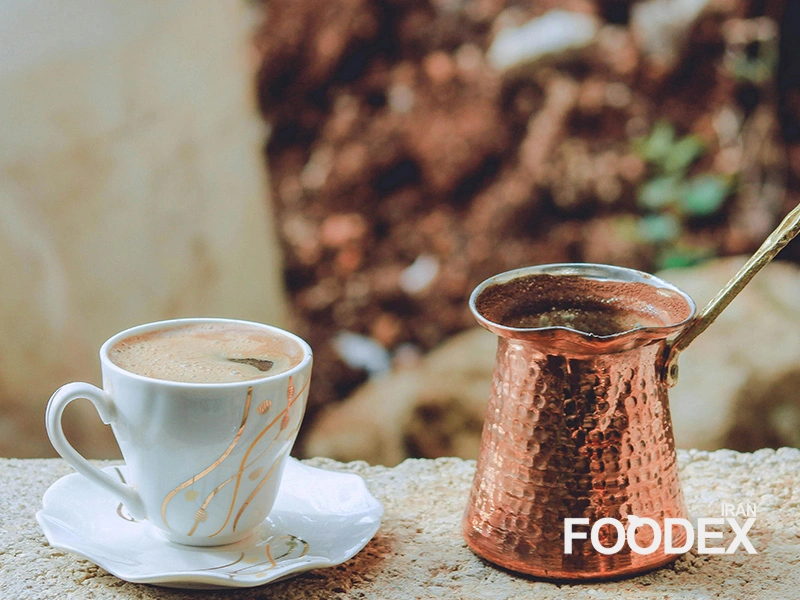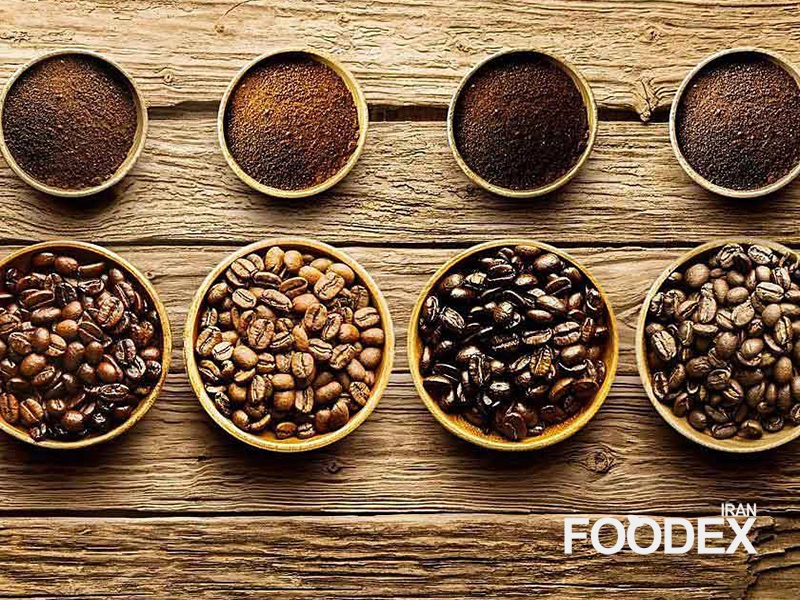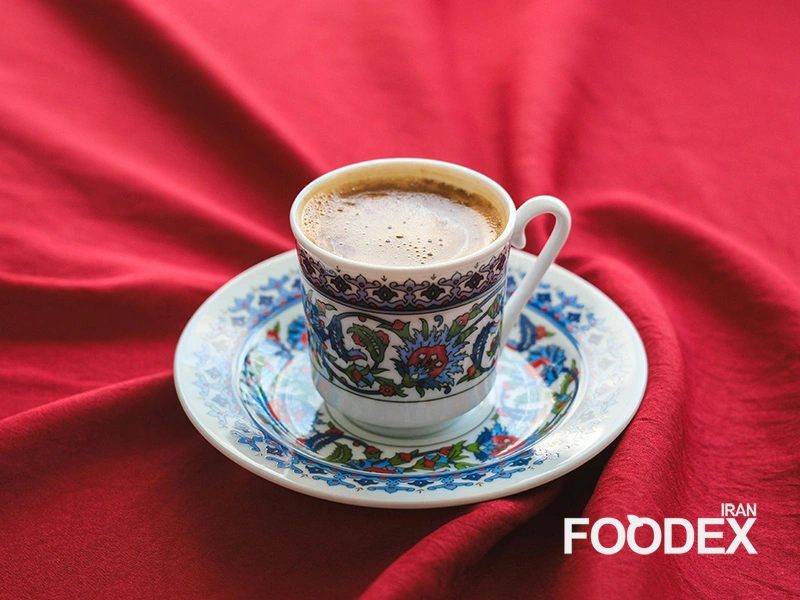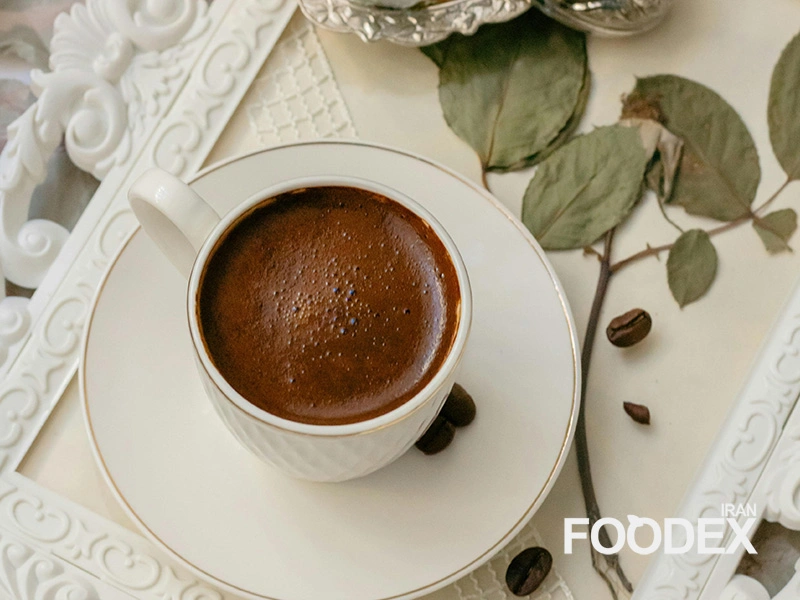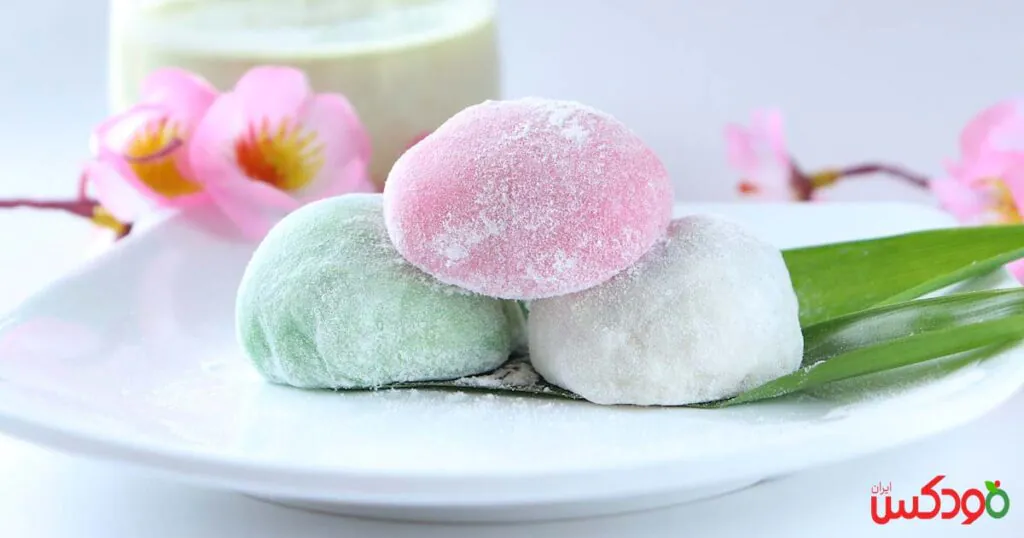Achieving the rich flavor and velvety texture of Turkish coffee at home goes beyond following a simple recipe; it requires understanding the subtleties of a unique brewing method steeped in history. This beverage, culturally significant in many countries, offers a distinct coffee experience characterized by its famous thick foam (kaymak), holding a special place among coffee enthusiasts.
In this expert guide from the Foodex blog, we aim to familiarize you with the key principles and precise steps for preparing an authentic cup of Turkish coffee. From selecting the right powder and understanding the crucial grind size to meticulous heat control and achieving the ideal consistency, we will cover all the necessary points step-by-step to ensure the best results. If you are keen on exploring the diverse world of beverages and wish to enhance your skills, we recommend exploring other specialized articles in our Cooking Tutorials section on the Foodex blog alongside this one.
Join us as we delve into the secrets of preparing a flawless and memorable Turkish coffee.
A Quick Look at Coffee
Before we delve into the unique brewing method of Turkish coffee, a brief introduction to coffee itself is worthwhile. This popular global beverage is derived from the roasted and ground beans of the Coffea plant, primarily cultivated in tropical regions. Its two main commercial species, Arabica and Robusta, have significant differences in terms of flavor, aroma, and caffeine content.
The quality and type of coffee bean, the roasting degree, and especially the grind size play a crucial role in the final taste of your cup. For Turkish coffee, Arabica beans are typically used, ground to a very, very fine powder (like flour). This extremely fine grind is fundamental to achieving the specific texture and taste characteristic of this brewing method. Now that we’ve covered these brief basics, let’s take a closer look at the history and characteristics of Turkish coffee.
History of Turkish Coffee: From Istanbul’s Coffeehouses to World Heritage
While coffee’s earliest roots trace back to Africa, the distinct chapter of Turkish coffee began in the 16th century within the heart of the Ottoman Empire. Following coffee’s introduction, the world’s first coffeehouses quickly emerged in Istanbul, becoming vibrant centers for social interaction, cultural exchange, and even political discourse. It was in this environment that the unique brewing method using small, long-handled pots known as a ‘cezve’ (also called ‘ibrik’) was developed and perfected, a method producing a thick, unfiltered coffee with a distinct foam, laying the foundation for what we know today as Turkish coffee.
This style of coffee preparation became so intertwined with Ottoman culture that it became integral to hospitality customs and even inspired the tradition of fortune-telling (tasseography) by interpreting the patterns left by the grounds in the cup. This brewing method and its surrounding culture, which spread beyond the Empire’s borders and became popular in various regions, has been inscribed on UNESCO’s Representative List of the Intangible Cultural Heritage of Humanity in recognition of its historical and cultural significance. It is this rich heritage that lends depth and meaning to the modern-day cup of Turkish coffee.
Bean Selection and Sweetness Level: Keys to Ideal Turkish Coffee
Although Turkish coffee is foremost a unique preparation method, the choice of coffee bean significantly impacts the final taste in your cup. Traditionally, Arabica beans are the preferred choice for Turkish coffee due to their rich aroma and milder flavor profile. Using Robusta, or a blend including it, can increase the beverage’s caffeine content and bitterness. Another critical factor is the grind size; for Turkish coffee, the powder must be extremely fine, almost like flour or cocoa powder, to allow for optimal extraction during the short brewing time.
A key characteristic of preparing Turkish coffee is adjusting the sweetness level before placing it on the heat. Unlike many other methods where sweetener is added afterwards, in the Turkish technique, sugar is mixed with the coffee powder and cold water in the cezve right from the start. Four main levels of sweetness are common:
- Sade (Plain – no sugar)
- Az Şekerli (Little Sugar – approx. half a teaspoon per cup)
- Orta Şekerli (Medium Sugar – approx. one teaspoon per cup)
- Şekerli (Sweet – approx. one and a half to two teaspoons per cup)
Choosing one of these levels depends on your preference and must be decided at the very beginning of the process.
What Exactly is Turkish Coffee?
After covering the history and preliminary tips, the main question remains: what exactly is Turkish coffee? Contrary to common belief, Turkish coffee is not a specific type of bean, but rather a unique method of brewing coffee defined by distinct characteristics. The foundation of this method is the use of coffee ground to an extremely fine powder (like flour). This powder is combined with cold water (and sugar, if desired, as discussed earlier) directly in a special pot called a cezve (or ibrik) and gently heated over low heat. The goal is to bring the coffee close to a boil without letting it bubble vigorously, allowing a thick foam known as kaymak to form on the surface.
The result of this process is a thick, potent, unfiltered beverage served in small cups, allowing the coffee grounds to settle at the bottom (this sediment also forms the basis for fortune-telling). The kaymak, or foam, is considered a sign of quality and skill in preparation and is an important part of the Turkish coffee drinking experience. Rooted in tradition and culture, this brewing method offers a completely different experience compared to filtered coffee or espresso. Now, we are ready to walk through the preparation steps.
How to Make Authentic Turkish Coffee with a Cezve (Traditional Method)
To prepare authentic Turkish coffee, you will need a special small pot with a long handle called a cezve (also known as an ibrik). These pots are typically made of copper, brass, or stainless steel. The traditional method requires some care and patience but yields an exceptional result with excellent aroma, flavor, and foam (kaymak).
Ingredients (Per Cup)
1 heaped teaspoon Turkish coffee powder (must be extremely finely ground)
1 cup cold water (use the small Turkish coffee cup you plan to serve in as your measuring cup for water)
Sugar (Optional) – adjust to taste based on the four levels:
Sade: Plain (no sugar)
Az Şekerli: Little Sugar (approx. 0.5 teaspoon)
Orta Şekerli: Medium Sugar (approx. 1 teaspoon)
Şekerli: Sweet (approx. 1.5 – 2 teaspoons)
Preparation Steps
Combine the cold water, Turkish coffee powder, and sugar (if using) directly in the cezve.
Using a small spoon, stir the mixture gently just once only until combined. Very Important: Do not stir the coffee again after this initial mix, as stirring will dissolve the foam (kaymak).
Place the cezve on the lowest possible heat setting on your stove. The heat must be very gentle to allow the coffee to brew slowly (this process may take several minutes).
Watch the process carefully and patiently. As the coffee heats up, a dark, thick foam (kaymak) will start to form on the surface and rise. This foam is a sign of well-prepared Turkish coffee.
The Critical Moment: Just before the coffee reaches a rolling boil (do not let it bubble vigorously), as soon as you see the foam rise up filling the neck of the cezve, immediately remove the pot from the heat. (Remember: boiling the coffee will destroy the foam and make the coffee taste overly bitter).
After removing from the heat, you can let it sit for a few seconds for the foam to stabilize slightly. Then, pour the coffee slowly and carefully into small, traditional Turkish coffee cups, trying to distribute the precious foam evenly among the cups.
Let the coffee cup rest for about one minute to allow the coffee grounds (telve) to settle completely at the bottom. Drink the coffee while it’s hot, sipping carefully to avoid disturbing the grounds.
Can Turkish Coffee Be Made with a Moka Pot?
You might wonder if it’s possible to use a Moka pot, commonly found in homes for making espresso-like coffee, to prepare Turkish coffee as well. The short and technical answer is no, and there are compelling reasons why. We strongly advise against attempting this for both safety and quality reasons.
The primary reason for this incompatibility lies in the most critical characteristic of Turkish coffee powder: its extremely fine grind size (almost like flour or cocoa powder). Moka pots have a metal filter designed for coffee ground to a medium coarseness (slightly coarser than espresso). The exceptionally fine Turkish coffee powder easily clogs these filter pores.
A clogged Moka pot filter has two serious consequences:
Safety Risks: Most importantly, when the path for water and steam is blocked, pressure builds up significantly and uncontrollably in the lower chamber of the pot. This pressure increase can be very dangerous, potentially damaging the device, causing hot water to spray, or even leading to the pot bursting.
Incorrect Brewing Method: Moka pots brew coffee using steam pressure over a relatively short time. In contrast, Turkish coffee is brewed over direct, low heat, slowly and without pressure in a cezve, allowing for full extraction and the formation of the characteristic foam (kaymak). These two processes are fundamentally different.
Therefore, even if the Moka pot doesn’t fail due to clogging, the resulting beverage will be fundamentally different from authentic Turkish coffee; it will lack the thick kaymak (foam) and won’t possess the unique taste and texture. For a genuine Turkish coffee experience, and more importantly, for your own safety, we strongly recommend always using the traditional and safe method with a cezve (Cezve/Ibrik). Strictly avoid using Turkish coffee powder in a Moka pot.
How to Make Turkish Coffee with Milk (Sütlü Türk Kahvesi)
If you find the traditional Turkish coffee a bit too strong, or if you’re simply looking for variety, preparing it with milk offers an appealingly milder alternative. In Turkey, this version is known as Sütlü Türk Kahvesi.
For this method, simply replace the entire amount of cold water specified in the main recipe (for the traditional cezve method) with the same amount of cold milk. The preparation steps are otherwise identical: combine the Turkish coffee powder (same amount per cup as before), cold milk, and sugar (if you prefer sweet coffee) in the cezve from the start, stirring gently only once.
Extremely Important Note: When using milk, you must maintain a very, very low heat setting on your stove (even lower than when using water) and watch the cezve attentively the entire time. Milk heats up very quickly, boils over much more easily than water, and if the heat is even slightly too high or you look away for a moment, it can quickly scorch on the bottom of the cezve, ruining the entire beverage’s flavor.
Be patient, allowing the coffee to heat slowly and foam up. As soon as the foam rises and before it starts to bubble or boil over, remove the cezve from the heat. Pour gently into the cup. Note that the foam produced with milk might differ slightly from that made with water. Let it rest for about a minute for the grounds to settle, then enjoy the distinct, milder taste of Turkish coffee made with milk.
Conclusion: Achieving an Authentic Cup of Turkish Coffee
Preparing an authentic cup of Turkish coffee is more than following a simple recipe; it’s an exercise in precision and patience that culminates in a unique beverage steeped in cultural heritage. In this guide, we’ve explored the keys to success, highlighting the importance of using extremely finely ground coffee, cold water, very gentle heat in a cezve, and the skill of developing the kaymak (foam) without bringing the coffee to a rolling boil. We also covered the significance of setting the sweetness level from the start, the variation using milk, and explained the technical and safety reasons why using a Moka pot is unsuitable for this brewing method.
This traditional brewing method, rightfully recognized on UNESCO’s Intangible Cultural Heritage list, offers an opportunity to savor a profound flavor and participate in a centuries-old ritual. (Recall the famous Turkish proverb: “Coffee should be black as hell, strong as death, and sweet as love.”) We hope that by applying these guidelines, you can create an enjoyable and truly authentic Turkish coffee experience at home. Mastering this art may require a little practice, but the result is undoubtedly worth the effort.
To further explore the fascinating world of coffee, its diverse brewing methods, and other intriguing beverages, we invite you to read more articles in our Cooking Tutorials section on the Foodex blog.
Frequently Asked Questions (FAQ)
1- Does Arabica or Robusta coffee have more caffeine?
Robusta beans contain almost twice the caffeine of Arabica beans. Therefore, if you desire a beverage with higher caffeine content, you could use coffee with a higher percentage of Robusta, although its flavor is generally harsher and more bitter than Arabica. Arabica coffee offers a milder taste and richer aroma, which is often preferred for Turkish coffee.
2- Can Turkish coffee be made with a Moka pot?
No, it is strongly recommended that you avoid doing this. As explained in detail in the article, the extremely fine powder of Turkish coffee clogs the Moka pot’s filter. In addition to posing a serious safety risk due to uncontrolled pressure build-up, the final result is completely different and lacks the authentic kaymak (foam) and the characteristic taste and texture of genuine Turkish coffee. The best, safest, and correct method is to use a cezve (or ibrik).
3- How is Turkish coffee made with milk?
Simply replace all the cold water in the main cezve recipe with the same amount of cold milk. Add sugar (if desired) right at the beginning along with the coffee powder and milk, stirring only once gently. The crucial point is to use a very, very low flame and watch the pot constantly and carefully, as milk heats up much faster than water, boils over easily, and can quickly scorch on the bottom if neglected or if the heat is too high, ruining the taste. Remove the coffee from the heat just before it fully boils and as soon as the foam rises.



